
|
Great outburst occured on Oct. 24, and it bacame a naked eye comet of 2 mag. It still keeps so bright as 5.5 mag on Apr. 30 (Carlos Labordena). Now it is extremely faint and difficult to see. It was completely stellar just after the outburst. Then the coma had spread out and now it looks like a huge nebula. The coma diameter has increased up to about 90 arcmin in December and January. But now it is going away from the earth, and the diameter reduced to about 60 arcmin. Now it is getting lower and lower rapidly in the evening sky. It will be unobservable soon. But it will become observable in good condition in autumn again.
Date(TT) R.A. (2000) Decl. Delta r Elong. m1 Best Time(A, h)
May 17 5 50.19 35 15.1 4.101 3.306 33 5.7 18:31 (132, -3)
May 24 6 1.55 34 57.8 4.180 3.335 29 5.7 18:28 (130, -5)
|
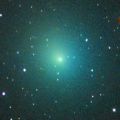
|
It is brightening much faster than expected. It is already so bright as 6.2 mag (May 14, Marco Goiato). The apparent size is so large as 20 arcmin. It will pass 0.85 A.U. from the sun in late June, and it may reach up to 4.5 mag. In the Northern Hemipshere, it is observable until around May 25, when the comet will be 6 mag. It will be unobservable for one and a half month around the perihelion passage. But it will appear in the morning sky again at 5.5 mag in early July, then it keeps observable after that while the comet is fading gradually. In the Southern Hemipsphere, it keeps observable all the period until the comet fades out, although it will be low in mid June.
Date(TT) R.A. (2000) Decl. Delta r Elong. m1 Best Time(A, h)
May 17 9 44.88 -23 59.0 0.308 1.106 99 6.5 18:31 (147, 77)
May 24 9 5.41 -25 0.8 0.271 1.031 86 5.8 18:28 (110, 67)
|
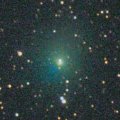
|
It reached up to 9.5 mag on Mar. 29 (Maik Meyer). Now it is fading slowly. It has already faded down to 10.7 mag (May 11, Marco Goiato). Diffuse object with a weak condensation. In the Northern Hemisphere, it will be unobservable soon, then it will never be observable again. In the Southern Hemisphere, it keeps observable until it fades out.
Date(TT) R.A. (2000) Decl. Delta r Elong. m1 Best Time(A, h)
May 17 6 54.03 3 9.6 1.728 1.343 50 10.8 18:31 (119, 30)
May 24 7 8.88 -0 43.5 1.796 1.383 49 11.0 18:28 (113, 31)
|
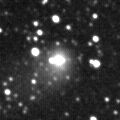
|
Now it is bright as 10.9 mag (May 11, Marco Goiato). It will keep 11 mag for a long time until August. In the Southern Hemisphere, it keeps observable in good condition until summer. In the Northern Hemisphere, the altitude will never be higher than 30 degrees in the evening sky, and the comet will be unobservable in July. It will appear in the morning sky again at 13 mag at the end of 2008, then it keeps bright and observable for a while.
Date(TT) R.A. (2000) Decl. Delta r Elong. m1 Best Time(A, h)
May 17 10 0.89 -19 53.5 2.417 2.808 102 11.2 18:31 (170, 75)
May 24 10 9.26 -17 31.9 2.481 2.796 97 11.2 18:28 (159, 71)
|
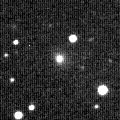
|
It is already very bright as 10.7 mag (May 14, Marco Goiato). It is expected to be 7 mag in September, but it is getting brighter than expected. However, it keeps moving in the southern sky, and it is unobservable for a while in the Northern Hemisphere. It will appear in the evening sky at 7 mag in late September, but it keeps locating in the evening low sky until the end of 2008 when it fades out down to 10 mag. Then it turns to appear in the morning sky, and it keeps observable in the northern sky after that while fading gradually. In the Southern Hemisphere, it keeps observable until late October after this.
Date(TT) R.A. (2000) Decl. Delta r Elong. m1 Best Time(A, h)
May 17 5 39.81 -33 50.8 2.620 2.303 60 11.7 18:31 ( 70, 35)
May 24 5 48.05 -33 48.9 2.547 2.220 59 11.5 18:28 ( 69, 32)
|
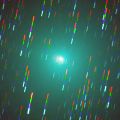
|
It passed near by Earth in early January, and it became a bright large object at 5.4 mag (Jan. 3, Seiichi Yoshida). It was visible with naked eyes. Now it is fading rapidly. It has already faded down to 11.3 mag (May 10, Marco Goiato). It will be fainter than 13 mag in late May. It has already moved away towards the southern sky, and it is no longer observable in the Northern Hemisphere. In the Southern Hemisphere, it keeps observable until it fades out.
Date(TT) R.A. (2000) Decl. Delta r Elong. m1 Best Time(A, h)
May 17 8 27.29 -62 52.5 1.412 1.869 99 11.9 18:31 ( 22, 58)
May 24 9 5.28 -61 52.9 1.465 1.941 101 12.4 18:28 ( 21, 60)
|

|
It will reach to 11 mag in summer. It must have already brightened up to 14 mag, but the comet was not observed recently. The condition in this apparition is bad. In the Southern Hemisphere, it keeps extremely low, or under the horizon, so it will not be observable. In the Northern Hemisphere, it is not observable until August when it appears in the morning sky at 11 mag. After August, it keeps observable and fading in the morning sky.
Date(TT) R.A. (2000) Decl. Delta r Elong. m1 Best Time(A, h)
May 17 2 41.66 -0 23.5 2.424 1.553 23 12.2 5:21 (268, 4)
May 24 3 0.81 2 9.3 2.383 1.517 24 12.0 5:25 (264, 5)
|
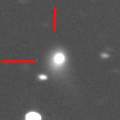
|
It brightened up to 13.5 mag and became visible visually in 2007 autumn (Nov. 13, Juan Jose Gonzalez). It had been unobservable for a while, but now it is appearing in the morning sky. Now it is 13.0 mag (Apr. 27, J. Broughton), brightening as expected. It will reach to 10.5 mag and will be observable in good condition in 2008 autumn. It keeps observable, visible visually, brighter than 14 mag for one year until 2009 May.
Date(TT) R.A. (2000) Decl. Delta r Elong. m1 Best Time(A, h)
May 17 0 50.91 26 8.7 3.489 2.770 38 12.1 5:21 (230, 8)
May 24 1 3.05 28 6.9 3.408 2.735 41 12.0 5:25 (225, 10)
|
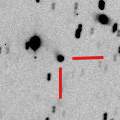
|
Now it is 13.0 mag, already visible visually (May 12, Juan Jose Gonzalez). It will be bright at 12 mag for a long time from 2008 spring to 2009 spring. However, it is only observable until August in the Northern Hemisphere because the comet moves southwards. It keeps observable for a long time in the Southern Hemisphere.
Date(TT) R.A. (2000) Decl. Delta r Elong. m1 Best Time(A, h)
May 17 17 53.16 -13 14.0 2.368 3.260 146 12.5 2:14 (180, 68)
May 24 17 42.99 -15 1.7 2.269 3.219 155 12.4 1:37 (180, 70)
|
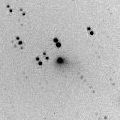
|
New comet. It is bright as 12.3 mag, and visible visually (May 12, Juan Jose Gonzalez). In the Northern Hemisphere, it keeps observable at 12-13 mag for a long time after this until autumn. It will move near by the Northern Pole from summer to autumn, and will be observable all night. Then it keeps observable until 2009 spring when the comet becomes faint. In the Southern Hemisphere, it is only observable until mid June.
Date(TT) R.A. (2000) Decl. Delta r Elong. m1 Best Time(A, h)
May 17 21 18.52 21 39.9 1.640 1.879 86 12.8 5:21 (185, 33)
May 24 21 26.15 27 44.6 1.571 1.845 88 12.6 5:19 (180, 27)
|
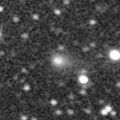
|
New comet. It is bright as 12.7 mag, and visible visually (May 12, Juan Jose Gonzalez). It keeps observable in good condition until autumn. But it is moving southwards gradually, and the altitude will be getting somewhat lower in the Northern Hemisphere. The calculation says it keeps bright at 13 mag for a while. However, it can be in a temporary outburst now, and it may be a very faint short periodic comet originally. It may fade out very rapidly after this.
Date(TT) R.A. (2000) Decl. Delta r Elong. m1 Best Time(A, h)
May 17 17 0.72 -13 53.0 1.487 2.458 159 13.6 1:22 (180, 69)
May 24 16 55.82 -14 10.3 1.466 2.461 166 13.6 0:50 (180, 69)
|
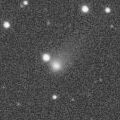
|
Now it is very bright as 12.7 mag (Apr. 12, Marco Goiato). It will keep visible visually at 13 mag until June.
Date(TT) R.A. (2000) Decl. Delta r Elong. m1 Best Time(A, h)
May 17 11 59.04 -0 25.4 2.448 3.123 123 13.6 20:17 (180, 56)
May 24 11 58.60 -1 26.4 2.507 3.103 117 13.6 19:49 (180, 57)
|

|
It was 15 mag on Jan. 14 (Michael Mattiazzo), brightening as expected. It will reach to 13.5 mag in the southern sky in spring and summer. In the Southern Hemisphere, it keeps observable for a long time after this. But in the Northern Hemisphere, it is not observable now. But it will appear in the morning sky at 15 mag in November, then it keeps observable while the comet will be fading slowly.
Date(TT) R.A. (2000) Decl. Delta r Elong. m1 Best Time(A, h)
May 17 4 55.36 -42 17.9 2.775 2.507 64 13.7 18:31 ( 57, 30)
May 24 5 19.44 -41 47.0 2.757 2.502 64 13.7 18:28 ( 58, 30)
|

|
After an outburst on Dec. 29, some outbursts occured repeatedly until mid January. It became very bright as 10.4 mag on Jan. 15 (P. Clay Sherrod). Then it is fading gradually. But it was still bright as 12.7 mag on Mar. 5 (Juan Jose Gonzalez). Now it is 13.7 mag (Apr. 4, Carlos Labordena), and extremely diffuse. It will be too low to observe at the end of May.
Date(TT) R.A. (2000) Decl. Delta r Elong. m1 Best Time(A, h)
May 17 6 24.56 27 39.9 6.773 6.024 39 14.0 18:31 (131, 7)
May 24 6 29.98 27 30.5 6.841 6.026 33 14.0 18:28 (128, 5)
|
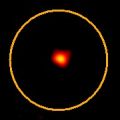
|
It was so faint as 17.2 mag on Apr. 27 (E. Guido, G. Sostero). But now it must be brightening very rapidly. Terry Lovejoy reported that it is already very bright as 12-13 mag on May 14. It is expected to reach up to 12 mag in June and July. However, it keeps locating extremely low for a while in the Northern Hemisphere. It will be getting higher gradually after late July, then it keeps observable while fading gradually.
Date(TT) R.A. (2000) Decl. Delta r Elong. m1 Best Time(A, h)
May 17 0 19.93 -2 56.0 1.363 1.107 53 14.7 5:21 (247, 34)
May 24 0 50.62 0 57.1 1.346 1.063 51 14.2 5:25 (243, 32)
|
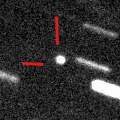
|
Now it is 13.8 mag (May 12, Juan Jose Gonzalez), brightening as expected and already visible visually. It is getting higher gradually in the morning sky. It is expected to reach to 6 mag in 2009 February. After this, it keeps observable until October when it becomes 11 mag.
Date(TT) R.A. (2000) Decl. Delta r Elong. m1 Best Time(A, h)
May 17 21 51.32 -12 5.8 3.266 3.427 90 14.4 5:21 (210, 64)
May 24 21 48.57 -12 16.2 3.060 3.353 97 14.2 5:25 (190, 67)
|
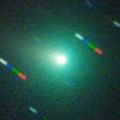
|
It brightened up to 8.3 mag on Feb. 6 (Juan Jose Gonzalez). However, now it is fading and getting diffuse very rapidly. It has already faded down to 12.5 mag (Apr. 29, Mitsunori Tsumura). It will be too faint to see visually soon. In the Northern Hemisphere, it keeps observable in good condition until July when it becomes fainter than 18 mag.
Date(TT) R.A. (2000) Decl. Delta r Elong. m1 Best Time(A, h)
May 17 8 58.95 29 18.0 1.675 1.682 72 14.5 18:31 (163, 24)
May 24 9 19.61 27 36.6 1.783 1.742 71 15.0 18:28 (161, 25)
|
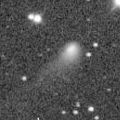
|
Now it is 12.9 mag (Apr. 27, Sandor Szabo and Zoltan Toth), very bright visually. It keeps observable visually at 13 mag at high location for a while.
Date(TT) R.A. (2000) Decl. Delta r Elong. m1 Best Time(A, h)
May 17 16 12.94 20 34.8 4.860 5.663 139 14.6 0:34 (180, 34)
May 24 16 4.19 21 20.4 4.879 5.671 137 14.6 23:53 (180, 34)
|

|
New comet. It will approach to the sun down to 0.44 A.U. on June 19. So it will brighten very rapidly after this. In the Northern Hemisphere, it will be observable at 13 mag in the morning low sky from early June to mid June. Then it will never be observable again. In the Southern Hemisphere, it is observable only until late May.
Date(TT) R.A. (2000) Decl. Delta r Elong. m1 Best Time(A, h)
May 17 23 52.27 2 12.2 0.859 0.907 57 15.7 5:21 (237, 36)
May 24 0 33.56 16 59.5 0.753 0.779 49 14.8 5:25 (227, 23)
|
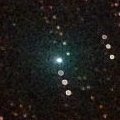
|
It brightened up to 8.5 mag on Jan. 6 (Alexandre Amorim). It kept bright until March, however, now it is getting diffuse and fading rapidly. It has already faded down to 12.0 mag (Mar. 30, Marco Goiato). It will be too low to observe in late May.
Date(TT) R.A. (2000) Decl. Delta r Elong. m1 Best Time(A, h)
May 17 6 54.46 6 52.4 3.108 2.571 49 14.9 18:31 (122, 27)
May 24 7 0.84 8 3.1 3.281 2.655 44 15.2 18:28 (119, 23)
|
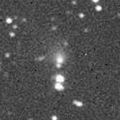
|
It is already bright as 14.7 mag and visible visually (Mar. 5, Seiichi Yoshida). It is expected to reach to 11 mag in 2009 summer. Because it moves in the northern sky, it keeps observable until it becomes brightest in the Northern Hemisphere. But it becomes low from April to June.
Date(TT) R.A. (2000) Decl. Delta r Elong. m1 Best Time(A, h)
May 17 3 34.35 56 37.9 5.723 4.957 37 14.9 5:21 (220,-33)
May 24 3 38.57 56 59.9 5.687 4.911 36 14.9 5:25 (219,-30)
|
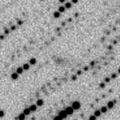
|
It was recovered at 18.7 mag on Mar. 3, as bright as expected (R. E. Hill). Then it is brightening rapidly as expected, and already brightened up to 15.5-16.0 mag (Apr. 14, Michael Jager). It will reach to 15 mag in May. In the Southern Hemisphere, it keeps observable in good condition until it fades out. In the Northern Hemisphere, the condition is bad. It will be too low to observe in mid May.
Date(TT) R.A. (2000) Decl. Delta r Elong. m1 Best Time(A, h)
May 17 22 2.94 -22 43.4 0.295 1.061 91 15.1 5:21 (231, 72)
May 24 22 54.18 -29 49.5 0.321 1.062 90 15.3 5:25 (258, 72)
|
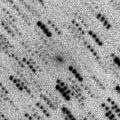
|
Although it had been extremely fainter than expected until March, it brightened very rapidly in April. It became very bright and visible visually at 11.3 mag (Apr. 12, Marco Goiato). However, it was difficult to see because extremely diffuse. CCD observers reported it so faint as 15 mag. This comet tends to be brightest after the perihelion passage. In the Northern Hemisphere, it had been low until March, but now it locates high. It will be visible visually at 12-13 mag until early May in the good condition.
Date(TT) R.A. (2000) Decl. Delta r Elong. m1 Best Time(A, h)
May 17 20 32.37 17 30.6 0.698 1.311 98 15.1 4:53 (180, 38)
May 24 20 36.14 20 38.2 0.721 1.357 101 15.6 4:29 (180, 34)
|
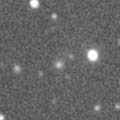
|
In the Southern Hemisphere, it keeps 15-16 mag and observable in good condition until summer. In the Northern Hemisphere, it will never be observable again.
Date(TT) R.A. (2000) Decl. Delta r Elong. m1 Best Time(A, h)
May 17 20 48.57 -50 50.7 2.686 3.210 112 15.4 5:09 ( 0, 74)
May 24 20 49.89 -51 3.4 2.653 3.249 117 15.4 4:43 ( 0, 74)
|
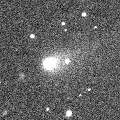
|
It brightned up to 13.4 mag on Jan. 4 (Seiichi Yoshida). Now it is fading. It was still visible visually at 14.4 mag on Mar. 5 (Seiichi Yoshida). But it has already faded down to 15.6 mag (Apr. 6, Ken-ichi Kadota).
Date(TT) R.A. (2000) Decl. Delta r Elong. m1 Best Time(A, h)
May 17 8 45.26 10 29.4 3.210 3.100 74 15.9 18:31 (151, 40)
May 24 8 54.10 9 53.0 3.332 3.138 70 16.1 18:28 (147, 39)
|
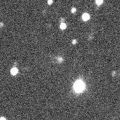
|
Now it is 17.4 mag (Mar. 10, Mitsunori Tsumura). It will be observable at 16-17 mag from April to July. It will be fainter than 18 mag in August. It keeps locating in the evening sky all time.
Date(TT) R.A. (2000) Decl. Delta r Elong. m1 Best Time(A, h)
May 17 9 13.10 12 22.7 0.898 1.238 80 16.2 18:31 (161, 41)
May 24 9 36.12 10 22.9 0.902 1.232 79 16.2 18:28 (160, 43)
|
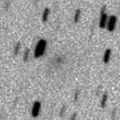
|
It will reach to 16 mag from May to July, and will be observable in good condition.
Date(TT) R.A. (2000) Decl. Delta r Elong. m1 Best Time(A, h)
May 17 20 21.87 83 35.2 1.805 1.789 72 16.3 4:44 (180,-29)
May 24 17 45.78 83 24.1 1.746 1.781 75 16.2 1:44 (180,-28)
|
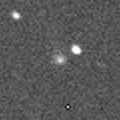
|
Now it is 16.8 mag (Feb. 29, Ken-ichi Kadota). It keeps 16 mag for one year from 2008 spring to 2009 spring. In the Northern Hemisphere, it keeps observable in good condition while the comet is brightening until 2008 spring. But the comet moves southwards after that, and it will never observable after 2008 July.
Date(TT) R.A. (2000) Decl. Delta r Elong. m1 Best Time(A, h)
May 17 10 57.20 5 22.7 3.583 3.999 107 16.3 19:15 (180, 50)
May 24 10 53.92 4 25.1 3.668 3.971 99 16.3 18:44 (180, 51)
|
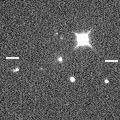
|
Now it is 16.1 mag (Mar. 9, Ken-ichi Kadota), brightened as expected. Although it had been observable in good condition for a while, it will be getting lower rapidly after this. It becomes unobservable in June.
Date(TT) R.A. (2000) Decl. Delta r Elong. m1 Best Time(A, h)
May 17 9 55.59 0 34.6 1.010 1.483 94 16.7 18:31 (173, 54)
May 24 10 6.16 -3 22.8 1.071 1.495 91 16.8 18:28 (166, 58)
|

|
Now it is 18.9 mag (Apr. 26, W. T. Ryle). It will be brightening rapidly after this. It will reach up to 9 mag and keep bright for a long time from summer to autumn. In the Northern Hemisphere, it becomes low in the south at brightest, but it keeps observable until it fades out.
Date(TT) R.A. (2000) Decl. Delta r Elong. m1 Best Time(A, h)
May 17 18 52.76 10 54.2 0.907 1.686 122 16.9 3:13 (180, 44)
May 24 19 0.30 12 7.2 0.832 1.643 125 16.7 2:53 (180, 43)
|

|
No observations have been succeeded since 2007 July. Now it is appearing in the morning sky, and it is predicted to be so bright as 14 mag. But actually, it was not detected, fainter than 16.8 mag on Apr. 12 (Esteban Reina Lorenz). It seems to be much fainter than expected. It will be observable in good condition from spring to summer. However, maybe it has already disappeared.
Date(TT) R.A. (2000) Decl. Delta r Elong. m1 Best Time(A, h)
May 17 21 43.34 -2 23.1 1.826 2.073 89 16.9 5:21 (199, 56)
May 24 21 52.95 -0 12.4 1.778 2.087 92 16.8 5:25 (189, 55)
|
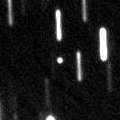
|
Peculiar asteroid moving on a cometary orbit. It reached up to 15.0 mag on Mar. 11 (Katsumi Yoshimoto). It has passed the perihelion in late January, but still completely asteroidal. It is already going away from the sun and fading. In the Northern Hemisphere, it keeps observable until July when it becomes fainter than 18 mag.
Date(TT) R.A. (2000) Decl. Delta r Elong. m1 Best Time(A, h)
May 17 11 18.01 7 8.3 1.585 2.166 111 16.9 19:37 (180, 48)
May 24 11 27.34 7 46.8 1.698 2.208 106 17.1 19:18 (180, 47)
|

|
It is expected to reach up to 7.5 mag in winter, and will be observable in good condition. However, this comet has not been observed since 1986. It is predicted to be already brightening as 17 mag. The condition of this apparition is good. It keeps observable for a long time until 2009 early summer both in the Northern Hemisphere and Southern Hemisphere.
Date(TT) R.A. (2000) Decl. Delta r Elong. m1 Best Time(A, h)
May 17 20 40.40 -22 49.0 2.287 2.796 109 17.2 5:01 (180, 78)
May 24 20 44.29 -22 42.5 2.140 2.735 115 16.9 4:37 (180, 78)
|

|
It will be bright at 9-10 mag for a long time from spring to autumn in 2009. Now it is predicted to be so faint as 19 mag. But actually, it is 16-17 mag recently, much brighter than expected. Maybe it is in a temporary outburst.
Date(TT) R.A. (2000) Decl. Delta r Elong. m1 Best Time(A, h)
May 17 9 52.75 16 18.5 3.281 3.406 88 16.9 18:31 (174, 39)
May 24 9 56.08 15 58.6 3.348 3.370 82 16.9 18:28 (167, 38)
|
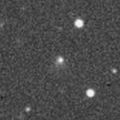
|
Now it is 16.7 mag (Feb. 16, Ken-ichi Kadota), brightened as expected. After this, it will be getting fainter slowly and getting lower slowly in the evening sky.
Date(TT) R.A. (2000) Decl. Delta r Elong. m1 Best Time(A, h)
May 17 10 45.68 28 49.9 2.166 2.470 95 17.0 19:04 (180, 26)
May 24 10 52.27 27 24.7 2.242 2.469 90 17.1 18:43 (180, 28)
|
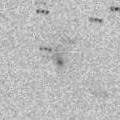
|
Now it is 16.5 mag (Apr. 22, Ken-ichi Kadota). It keeps observable in good condition while the comet will be fading slowly.
Date(TT) R.A. (2000) Decl. Delta r Elong. m1 Best Time(A, h)
May 17 13 35.75 72 5.1 2.708 2.829 86 17.2 21:51 (180,-17)
May 24 13 16.75 68 44.1 2.739 2.845 85 17.2 21:06 (180,-13)
|
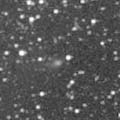
|
Now it is brightest at 17 mag. But it will be fading gradually, and it will be fainter than 18 mag in July.
Date(TT) R.A. (2000) Decl. Delta r Elong. m1 Best Time(A, h)
May 17 14 50.45 -13 49.4 3.166 4.160 167 17.2 23:07 (180, 69)
May 24 14 37.02 -13 16.2 3.238 4.193 157 17.3 22:26 (180, 68)
|
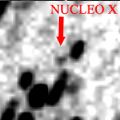
|
Now it is 18.8 mag (Apr. 25, V. Nevski). It keeps observable while the comet will be brightening gradually after this. It will reach up to 14.5 mag in autumn. However, then it locates low in the evening sky, and it will be unobservable soon in December.
Date(TT) R.A. (2000) Decl. Delta r Elong. m1 Best Time(A, h)
May 17 15 56.02 -5 4.7 1.947 2.935 164 17.5 0:17 (180, 60)
May 24 15 50.48 -4 28.9 1.905 2.890 163 17.3 23:40 (180, 59)
|
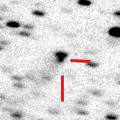
|
It was observed at 16.5-17 mag in 2006 and 2007. Because it is a very distant comet, it is observable at 17 mag still in 2008 in good condition.
Date(TT) R.A. (2000) Decl. Delta r Elong. m1 Best Time(A, h)
May 17 19 29.44 38 41.4 5.969 6.231 100 17.3 3:50 (180, 16)
May 24 19 23.65 39 54.4 5.932 6.248 103 17.3 3:17 (180, 15)
|
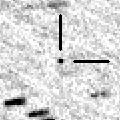
|
Brightening rapidly. It will reach to 14 mag in autumn. However, it locates extremely low in the Northern Hemisphere. It keeps higher than 30 degree even in the Northern Hemisphere until August, when it brightens up to 15 mag.
Date(TT) R.A. (2000) Decl. Delta r Elong. m1 Best Time(A, h)
May 17 10 35.59 37 13.1 1.680 1.954 89 17.4 18:54 (180, 18)
May 24 10 41.29 35 37.1 1.696 1.901 85 17.3 18:32 (180, 20)
|

|
It had been observed at 16.5 mag for a long time from 2005 to 2007. Now it is fading. But it keeps observable at 17.5 mag in good condition for a long time until July.
Date(TT) R.A. (2000) Decl. Delta r Elong. m1 Best Time(A, h)
May 17 14 0.48 15 31.8 7.815 8.593 137 17.4 22:18 (180, 40)
May 24 13 57.54 15 12.0 7.903 8.619 132 17.5 21:47 (180, 40)
|

|
It will approach to the sun down to 0.1 A.U. on June 17. It moves very fast in the northern sky in May. It is observable at 16 mag in good condition in first half of May in the Northern Hemisphere. It passes near by Polaris in mid May, and it will be unobservable at the end of May. If it shows a cometary activity, it may become much brighter than this ephemeris.
Date(TT) R.A. (2000) Decl. Delta r Elong. m1 Best Time(A, h)
May 17 6 8.93 84 8.6 0.195 0.949 66 17.5 18:31 (171,-31)
May 24 5 13.89 52 30.9 0.284 0.795 34 20.3 18:28 (138,-22)
|
|
![]()
 C/2006 OF2 ( Broughton )
C/2006 OF2 ( Broughton ) C/2007 G1 ( LINEAR )
C/2007 G1 ( LINEAR ) C/2008 J1 ( Boattini )
C/2008 J1 ( Boattini ) P/2008 J2 ( Beshore )
P/2008 J2 ( Beshore ) C/2007 B2 ( Skiff )
C/2007 B2 ( Skiff ) C/2006 U6 ( Spacewatch )
C/2006 U6 ( Spacewatch ) 29P/Schwassmann-Wachmann 1
29P/Schwassmann-Wachmann 1 15P/Finlay
15P/Finlay C/2007 N3 ( Lulin )
C/2007 N3 ( Lulin ) 46P/Wirtanen
46P/Wirtanen C/2005 L3 ( McNaught )
C/2005 L3 ( McNaught ) C/2008 J4 ( McNaught )
C/2008 J4 ( McNaught ) C/2007 T1 ( McNaught )
C/2007 T1 ( McNaught ) C/2006 W3 ( Christensen )
C/2006 W3 ( Christensen ) 197P/2008 E2 ( LINEAR )
197P/2008 E2 ( LINEAR ) 26P/Grigg-Skjellerup
26P/Grigg-Skjellerup C/2006 V1 ( Catalina )
C/2006 V1 ( Catalina ) C/2006 S5 ( Hill )
C/2006 S5 ( Hill ) 79P/du Toit-Hartley
79P/du Toit-Hartley C/2007 W3 ( LINEAR )
C/2007 W3 ( LINEAR ) C/2007 M2 ( Catalina )
C/2007 M2 ( Catalina ) 124P/Mrkos
124P/Mrkos 6P/d'Arrest
6P/d'Arrest C/2007 K3 ( Siding Spring )
C/2007 K3 ( Siding Spring ) 2005 WY3
2005 WY3 85P/Boethin
85P/Boethin 22P/Kopff
22P/Kopff 180P/2006 U3 ( NEAT )
180P/2006 U3 ( NEAT ) C/2008 H1 ( LINEAR )
C/2008 H1 ( LINEAR ) C/2007 M3 ( LINEAR )
C/2007 M3 ( LINEAR ) 68P/Klemola
68P/Klemola C/2005 S4 ( McNaught )
C/2005 S4 ( McNaught ) 7P/Pons-Winnecke
7P/Pons-Winnecke C/2002 VQ94 ( LINEAR )
C/2002 VQ94 ( LINEAR ) 2008 HW1
2008 HW1![]()


































